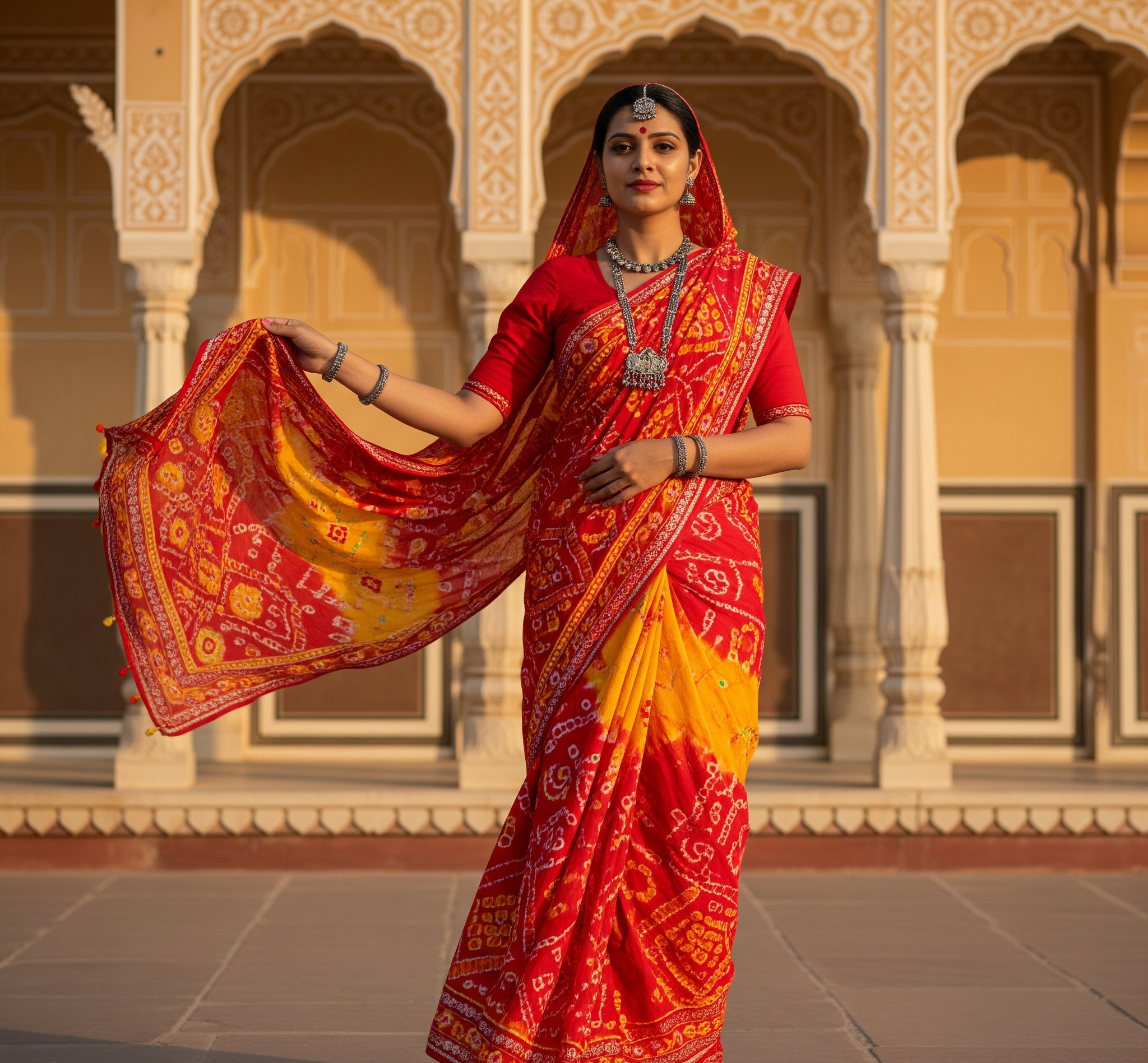Why Jaipuri Bandhej Sarees Are So Famous – History & Craft Explained

Jaipuri Bandhej sarees are a rich combination of tradition and bright colors. This unique tie-dye technique hails from the royal city of Jaipur and is preferred by women across the world. If you want to learn more about the culture of the sarees, this guide will give you an understanding of their fascinating history and how you can style them in a modern way.
Wearing a Jaipuri Bandhej saree is like embracing a world full of color, meaning, and emotion. Many sarees are valued for their look; Bandhej sarees are loved for their spirit. What truly sets Bandhej sarees apart is not only the tie-dye process but the reason that they are worn by women in the first place
The Rich History of Bandhej in Jaipur
Bandhej, also known as Bandhani, is one of the oldest textile crafts in India. This beautiful method of knotting (tying small parts of cloth with thread and then dyeing the fabric) started over 5,000 years ago with the Indus Valley Civilization. The threads are removed later, revealing a beautiful dotted pattern.
Jaipur's royal family supported the Bandhej craft. In the past, Rajput kings wore Bandhej turbans and shawls for many religious events and festivals. With this royal support, local artists created new designs and patterns. Jaipur artists became skilled at using deep and calm colors, like indigo. These colors helped show the true spirit of Rajasthan.
Bandhej sarees are not merely garments. They carry the long history of hard work and creativity that have been passed through generations and tell a story of tradition while simultaneously incorporating new ideas that are relevant to today’s fashion.
What Makes Jaipuri Bandhej Sarees Special?
Handmade Tie-Dye Technique
Sarees made in Jaipur follow the tradition of tightly tying the fabric with cotton threads before applying natural dyes, then sun drying in the desert. Each saree is hand-made, which makes it unique and worth the money.
Unique Designs from Jaipur
If you look closely, you will see designs inspired by Mughal gardens and flower patterns. Some of the patterns even reflect the plants and flowers of the desert and the old palace gardens of Jaipur. These designs bring Jaipur's amazing culture and landscapes to each saree.
Variety of Fabrics
These sarees used to be made only from pure cotton. Now, it can be found in silk-cotton blends and georgette. Because of these new fabrics, it's easy to find a saree for everyday wear or even for special events. The new fabrics offer comfort and higher durability compared to the earlier styles, which were stiffer and less flexible.
Significance of colors
Bandhej sarees are also very versatile. The fashion conscious crowd today is able to combine Bandhej sarees with modern blouses, trendy handbags, or even some sneakers for an edgy modern fusion look. Merging the old and the new gives Bandhej sarees an identity of now while still respecting its history. You will also discover that Bandhej sarees create moments of joy because of their colour stories
Specifically, the colors we value; The significance of a red saree is derived from marriage, the yellow saree is acknowledged for blessings, green symbolises growth, and so on. Therefore, when you purchase any Bandhej saree you are selecting more than just a print; you are selecting a feeling. Further elaborating, for the various tourists who journey through Rajasthan, a Bandhej saree is potentially an exit gift.
Buying Jaipuri Bandhej Sarees Online
Finding Jaipuri Bandhej sarees has become much easier with trusted websites that sell curated collections and you can filter down on fabric and design without having to browse the entire website. You are always able to view the images of the products in detail, and they will often also provide several different angles if it is a more complicated design. They offer a wider range of styles than physical stores. Online shopping is less original than a physical store, but is convenient for finding sarees quickly from home.
Styling Your Jaipuri Bandhej Saree
There are many variations of wearing a Jaipuri Bandhej saree. You can wear it for daily or casual wear-look, for events and family gatherings or to get that new modern look.
If you're going to work or doing daily tasks, pick a light cotton saree. Choose soft colors and a simple blouse. Wear casual slippers and no heavy jewelry. This look is neat, clean, and easy. Good for a visit to the temple or an office meeting.
For festivals or family gatherings, choose sarees in deeper and brighter colors with silver jewelry; you could even add a bindi and wear traditional shoes for a festive look. This will give you a festive look with minimal effort.
For a more modern look, you could wear a belt with your saree or drape it in a butterfly style or wear it with a crop top with or without fancy sleeves. Wear bold pieces of jewelry to make it look fresh and modern. Mixing old and new styles helps to create more trendy looks.
How to Take Care of Your Jaipuri Bandhej Saree
Gently hand wash your saree using a mild soap with cool water. Do not dry your saree in bright sunlight; the colors may fade. When you iron your saree place a piece of cloth over the design and make sure the iron is on a cotton setting. Fold your saree carefully along its lines. Keep it safe from dust by wrapping it in muslin cloth. This will help your saree stay clean and keep its colors bright for a long time!
Why Buying a Jaipuri Bandhej Saree Feels Special
A Jaipuri Bandhej saree is not simply a clothing piece. It represents meaning and history. This saree's beauty lasts forever. You will always look beautiful wearing it. These sarees are made from Indian fabrics such as cotton, silk and georgette. Each of these fabrics feel great on the skin and is comfortable to wear in every season.
When you buy a Bandhej saree, you also help the artists who make them. Each saree is made with great care, taking a lot of time and effort. The Bandhej process is a true example of handmade, skilled craft.
One saree can work for many events. You can wear it to a simple prayer, to the office or dress it up for a wedding.
Most importantly, these sarees showcase the art and pride of Jaipur. Each fold holds a story. The designs are vibrant and tell a tale of tradition. A Jaipuri Bandhej saree provides comfort, beauty and deep-rooted culture in one item.
Each Bandhej saree usually has a twin phenomena in making a lifelong memory when they are bought. The sarees are typically bought for major life events such as weddings, milestones in festivals, or specific cultural rituals. In many families, simply owning a Bandhej saree is symbolic of owning a memory.
Mothers pass them to their daughters ensuring that the love, pride, and care is not detached from the cloth. Furthermore, amidst being traditional,
Final Thoughts
The Jaipuri Bandhej saree is not just a style statement; it is part of India's rich craft. It incorporates modern style while maintaining its vintage charm. Visit KCPC Bandhani to order genuine Bandhej sarees online and support local artists, and you'll look royal in a modern way.
FAQs
1. Are all Bandhej sarees from Jaipur?
No. While the Jaipuri saree is differentiated for its motifs and colors, Bandhani is produced in many other towns across Rajasthan as well.
2. How do I know it’s hand-tied?
Appearances of tiny flaws like repeated dots or patterns suggest that some form of meticulous detailing has gone into the piece’s making, which will be noted as “hand-tied” or “original Bandhej,” so check labels too.
3. Can I wear it all year round?
Yes, its materials work differently in how conditions play out throughout the year, meaning cotton is ideal during summer, whilst silk blends or chiffon excel during winters and air-conditioned places.
4. Where can I buy Jaipuri Bandhej saree online?
Online customers looking for precise craftsmanship from Jaipur with vivid pictures of products alongside prices and fitting guides, can look at KCPC Bandhani stores as they deliver unmatched quality.
5. How do I drape it for a saree belt look?
To achieve this look, begin by wrapping your attire around yourself as you would traditionally put on a Sari then take a thin belt and fasten it at your waist where the pleats have been secured to showcase your curves while providing grip to the garment strands, trimming slippage.





